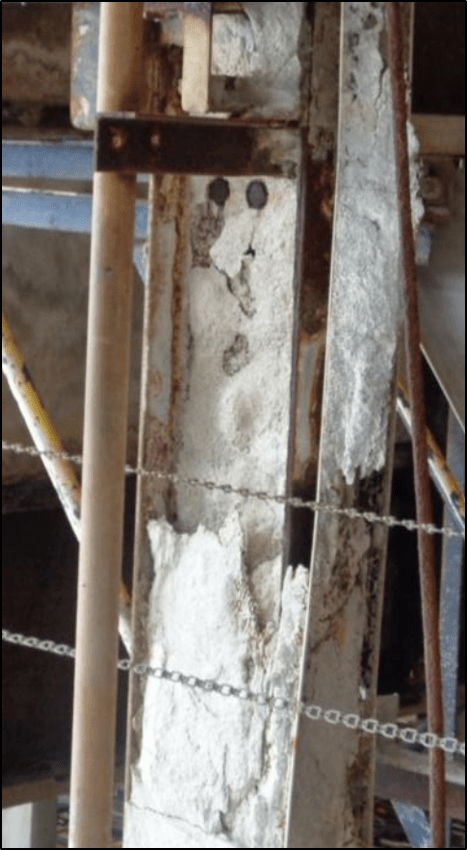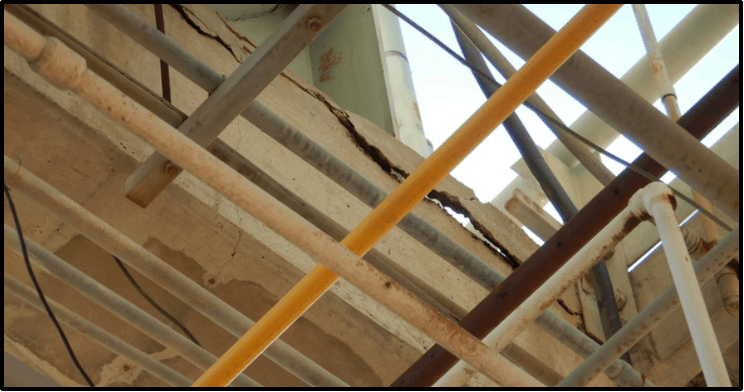Fireproofing Defect Likelihood: an inside look at how Brindley Engineering trains its engineers and technicians to identify and assess defects while providing the highest level of fireproofing services
Welcome to Part 2 of our series on Brindley Engineering’s commitment to engineering training for defect identification and assessment, ensuring top-tier fireproofing services. In Part 1 we explored fireproofing Condition Assessment strategies. Now, in Part 2, we continue our conversation with BE’s Chris Sedlacko to dive deeper into the BE fireproofing training program for employees. This time, we discuss Defect Likelihood.
Quiz Question: Which of the following issues should be categorized as HIGH Likelihood?
A. Cracking 1/8” to 1/4”
B. Rust Staining
C. Delaminated Mastic (Not Ready-To-Fall)
D. Loose and Unsound Normal-Weight FP
Q: What are some things you train your engineers to look for in identifying fireproofing defects?
A: For normal weight and lightweight concrete fireproofing we inspect each member for cracking, delamination, spalling or impending spalling. For Mastic material, which is inherently more flexible, it’s important to identify cracking, bulging, delamination, and trapped moisture.
Q: Why is this type of training important at BE?
A: It’s not just about having the ability to identify fireproofing defects, we train each inspector to understand how to identify different types of defects and why early signs are important. For example, cracking is usually the first sign of deterioration and can progress quickly if not addressed. Cracking allows water to infiltrate and can cause steel corrosion. Spalling and Delamination failures are due to expansion of internal mechanisms where the concrete separates from the substrate and can result in debris falling into lower platforms or equipment below the area. Mastic defects are indicated by cracking, bulging and delamination. Moisture is trapped against steel substrate and accelerates corrosion.
Q: What else do you train your team to look for?
A: We spend a lot of time talking about Defect Likelihood, which is defined by how soon a defect will result in a failure. There are three categories – high, medium, and low likelihood. Let’s break it down by instance:
Cracking:
- High Likelihood
- Cracking greater than 1/4” wide.
- Cracking less than 1/4” wide with Unsound Adjacent Concrete.
- Medium Likelihood
- Cracking 1/8” to 1/4” wide (Sound Concrete around cracks).
- Low Likelihood
- Cracking less than 1/8” wide (Sound Concrete around cracks).
Spalling and Delamination:
- High Likelihood
- Concrete fireproofing loose and unsound (Impending spall).
- Underlying structural steel exposed and corroded (Corrosion).
- Medium Likelihood
- Concrete fireproofing hollow, but not loose (Delamination).
- Underlying structural steel corroded visible (Rust staining).
- Low Likelihood
- Fireproofing spalling with no areas of delaminated or unsound concrete.
- Rust staining may be present on concrete surfaces.
Mastic:
- High Likelihood
- Mastic failing, cracking, bulging, or rust staining present over 66% to 100% of the member.
- Trapped moisture present within or beneath mastic.
- Mastic is loose and appears on the verge of falling (Impending Spall).
- Medium Likelihood
- Mastic failing, cracking, bulging, or rust staining present over 33% to 66% of the member.
- Mastic is separating from the member but is not on the verge of falling (Cracking & Delamination).
- Low Likelihood
- Mastic failing, cracking, bulging, or rust staining present over 0% to 33% of the member.
- Mastic is not separated from the member (Cracking only).
Q: What kind of technology is used in fireproofing assessments?
A: Determining Defect Likelihood, or time to failure, is a complex process that relies on the inspector’s training and expertise, collaboration with the inspection team and in-office engineers, evaluation of the surrounding environment, and analysis of adjacent structural members.
One key technological advancement in this process is the handheld tablet. Each inspection team is equipped with a tablet preloaded with previous inspection reports and Brindley’s extensive defect database, which contains thousands of data points. This invaluable tool enhances the accuracy and efficiency of Defect Likelihood assessments, providing inspectors with real-time insights to make informed decisions.
About Brindley Engineering Brindley Engineering was founded with a vision to provide the highest level of service to clients in capital & maintenance projects, reliability initiatives, and construction solutions. We’ve developed a world-class, multidisciplinary team of engineers, technicians, and designers that share that vision.
- Read Part 1 of this series
- Stay tuned for Part 3 of this series
- Get in touch today!



0 Comments